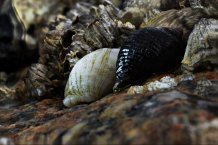Articles

Dogwhelks are highly important inhabitants of the seashore. Image courtesy of Kelvin Boot (PML).
Light pollution has serious impact on coastal wildlife, research shows
Scientists have recognised for some years that light pollution from buildings, vehicles and streetlights is a growing phenomenon that impacts on the behaviour and success of many animals including migrating birds, hunting bats and the moths they try to capture.
As the human population grows the problem is due to worsen and even remote coastal areas are now being affected by civilization’s tell-tale glow-in-the-sky. Turtles, disoriented as they return to their nesting beaches, or confused hatchlings struggling to find the sea, are iconic examples.
Now, a new study conducted by scientists from the University of Exeter and the Plymouth Marine Laboratory looks at the true extent to which light pollution is affecting key marine wildlife in the UK.
The research team set up a series of laboratory experiments to determine whether the less well known, but highly important inhabitants of the seashore were also affected. Using the dogwhelk (Nucella lapillus), a key seashore species that modulates biodiversity and community structure of our coasts, they kept one group of dogwhelks in artificially-lit night sky conditions, while a control group experienced a more natural night/day cycle.
The research showed that those dogwhelks kept under artificial lighting conditions were less likely to seek out shelter and spent longer seeking food – putting them at exposed risk to predators and placing them in more stressful conditions. The study showed, for the first time, that night time light changes species interactions at the heart of the way in which natural food chains work, raising concern about how generalised these impacts may be for natural marine wildlife.
Dr Thomas Davies from the University of Exeter highlighted how historically overlooked the impacts of light pollution on coastal ecosystems has been, saying: “There has been a surge of research into the impacts of artificial lighting on land animals and plants over the last six years, but the influence on coastal animals of lights from harbours, marinas, piers and promenades has received very little attention. Understanding how to manage ecosystems to improve biodiversity gains is as important in the built marine environment as it is in our city parks, gardens, streets, rivers and canals. This study highlights that night-time lighting in coastal cities can impact biodiversity on rocky shores popular with beachgoers that enjoy the diversity of life they offer year round.”
Dogwhelks are far from unimportant along rocky coasts, where they can occur in dense aggregations, and play a key role in the ecological balance, feeding on barnacles, limpets and mussels.
Disturbing these balances can have major ramifications across habitats and up food webs.
PML senior ecologist Dr Ana Queirós who co-authored the study said: “It is not just nesting turtles and hatchlings on the beaches that are affected: it is the whole way in which shore food chains work, because this is tightly dependent on species interactions such as the ones we measured: who eats who. We must be cautious with generalisations, but we have been slow in recognising night time light as a worldwide marine issue. However, unlike for climate change, the solution for night time light pollution is well within our reach, as restricting use of lights to specific colours can much limit their negative impacts on wildlife, as has been shown in terrestrial studies. We should be acting on coastal light pollution immediately, because this time, we can actually fix the problem.”
Date: 28 April 2017
